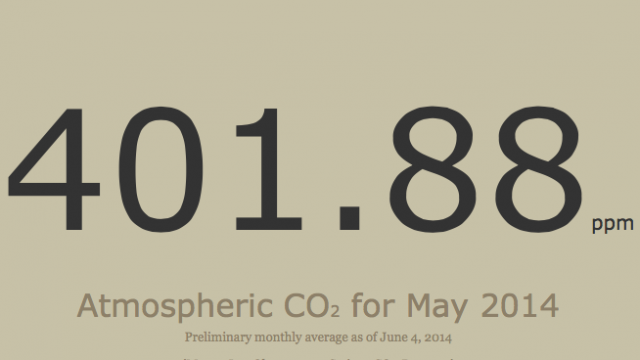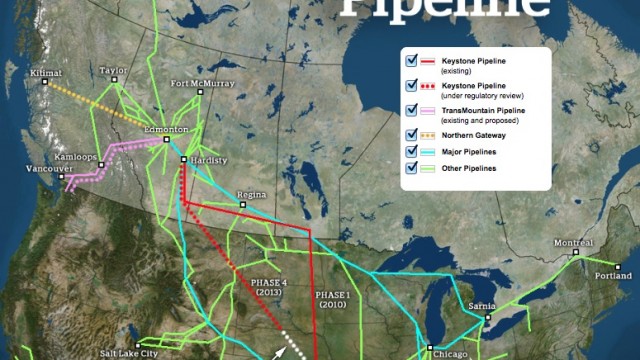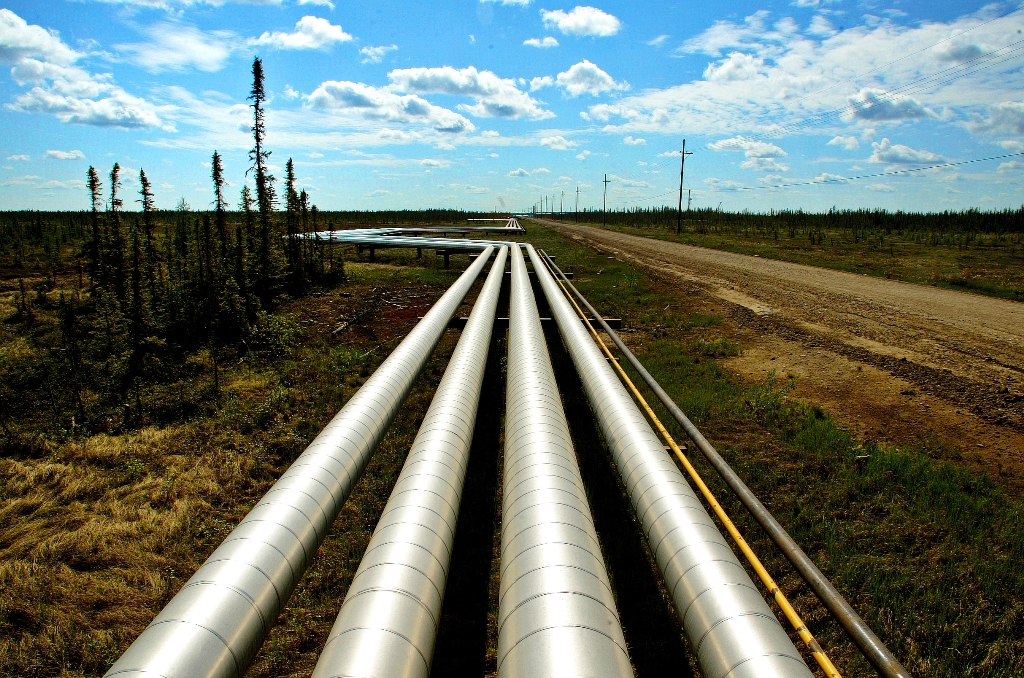But consent from First Nations and B.C. residents wholly absent
by Steve da Silva
The writing on the wall couldn’t have been written in bigger, bolder, and clearer letters over the past year: The relentless exploitation of fossil fuel is rushing the planet beyond a series of irreversible environmental tipping points. Melting glaciers. Acidifying oceans. An atmosphere reaching carbon levels not seen in millions of years. We are in the midst of what scientists call a “mass extinction” event that is directly attributable to capitalist economy. Species are being killed off at 1000 times the ‘background rate’ or normal rate at which species statistically go out of existence.
This is the context in which the National Energy Board and the Federal cabinet approved Enbridge’s Northern Gateway project, which plans to lay 1200 km of pipeline carrying diluted bitumen from Alberta to a northwest coast shipping terminus at Kitimat, B.C.
Last week’s decision was expected to yield a positive decision for the oil industry. In December 2013, a three-member Joint Review Panel – ostensibly “independent” from but mandated by the Ministry of Environment and the National Energy Board (NEB) – issued a report recommending approval for the project subject to the 209 conditions that the Federal cabinet last week set for the project’s go ahead. But this report has been analyzed as deeply flawed by the actually independent experts.
Scientific Opposition
On May 26, 250 members of the scientific community from throughout Canada and across the world published an Open Letter criticizing the “flawed analysis” of the Joint Review Panel’s assessment of the Northern Gateway project. As the letter highlighted who benefits and who will pay for Northern Gateway by drawing attention to the JRP’s “broad view of the economic benefits, but an asymmetrically narrow view of the environmental risks and costs.” The Open Letter concluded deemed the Joint Review Panel Report “as indefensible as a basis to judge in favour of the project.”
The Open Letter from scientists also brought attention to the proverbial elephant in the middle of the room: the Joint Review Panel’s complete exclusion of considerations for the increase in greenhouse gas emissions.
Climatologists argue that the proportion of atmospheric carbon that humans have evolved over the last couple hundred thousand years has been around 275 parts per million (ppm) of atmospheric molecules. As of the end of May 2014, the carbon content of the atmosphere stood at 400 ppm, well above the 350ppm that climatologists argue is necessary to preserve the current ecological equilibrium on earth. The relentless expansion of the fossil fuel industry into hydraulic fracturing (“fracking”), deep sea drilling, and oil sands is sealing the fate on irreversible ecological catastrophes.

The carbon content of the atmosphere as of May 2014, already a disastrous and climate changing level according to scientists, and climbing at a rate of 2 ppm / year and accelerating.
Northern Gateway to Where? Who benefits?
But none of this seems to matter to industry heads focused on their “bottom lines”. Since the financial collapse of 2007/08, corporations have been all the more desperate for profitable investment opportunities that seem increasingly elusive. But intensified resource exploitation is a seeming to be a sure-fire way for Canada to keep itself at the apex of a stagnant, crisis-ridden and profit-based capitalist world economy.
The planned and now approved pipeline would see an estimated 220 oil tankers port and load at Kitimat each year. Each day, the pipeline would fill 525,000 barrels of oil – a carrying capacity that Alberta’s oil industry is hungry for. In 2013, Alberta’s tar sands were already producing 1.95 million barrels a day, and the industry is planning for an upward expansion to 3.2 million barrels a day by 2020. This is why industry is hedging its bets with the southward flowing expansion of Keystone XL. When U.S. President Obama suspended the expansion of Keystone XL in 2011, Canada’s oil industry turned to Asia to become a new destination for its oil supplies.
If Northern Gateway goes online, it is estimated that it will bring tax revenue to B.C. of $1.2 billion dollars over a thirty year period . That’s less than $40 million a year. But these revenues are vastly dwarfed by the estimated clean-up costs of an oil spill on the northwest coast, which is estimated to range from anywhere between $2-$10 billion for such a disaster. Yet, for all the risks and costs, Enbridge is only claiming that the project will yield a mere 560 permanent jobs and 3000 short-term jobs to build the pipeline.

A detailed map of the oil pipelines running throughout Canada. Image taken from an interactive infographic at CBC.
The Two Mountains: Popular Opposition, Indigenous Resistance
Major obstacles remain to the project, which Enbridge hopes to operational by 2018; and those obstacles aren’t just the Rocky and Coastal mountains that lay in the proposed pipeline’s path.
For one, by all measures it is clear that the majority of B.C. residents oppose the project, even in Kitimat, B.C. Where one might expect to find the largest base of support given the concentration of jobs that would land in Kitimat’s small community of 9000, an April referendum saw 58% of voters oppose the project. The ruling parties at the Federal level and in B.C. are looking wearily at this as many a lost vote. Trudeau’s Liberals and Mulcair’s NDP have said they’d reverse the decision if elected in 2015. The Federal Green Party’s Elizabeth May, for her part, offered weak words of opposition saying that that “Next step is encouraging all British Columbians to use all democratic and peaceful and legal means to stop this pipeline.”
But beyond what’s legal and democratic is what’s ecological necessary and morally right, and such action is almost certainly forthcoming from the more firm opponents to be found amongst the Indigenous peoples of the northwest coast and interior nations.
First Nation communities must be “consulted” and won over as part of the 209 conditions that have been set out for Enbridge to meet – wise conditions for the Feds to set out, knowing that anything less would intensify the resistance that already exists to the project.
In December 2013, the First Nations Summit and Union of BC Indian Chiefs called upon the Feds to reject the Joint Review Panel’s recommendations and criticized the “the federal government [for] instead [chosing] to gut federal environmental protections, [and] unilaterally designed and imposed its greatly weakened environmental review process as a quick-and-dirty Aboriginal consultation process for the Enbridge Northern Gateway Project.”
In the wake of last week’s decision, Art Sterritt of the Coastal First Nations promised said in a statement that ““We’ll see if Enbridge dares to put its shovels in the ground… We will never allow oil tankers into our territorial waters.”
The Haida Nation added as unequivocally last week that: “We will take our fight to the land, sea and courts to uphold and protect Haida territory, and to ensure clean water, clean air, and a healthy way of life for future generations.”
Most importantly, perhaps, is the ongoing direct action by members of the Unist’ot’en Camp, who pledged to continue defending their territories “against the incursion of government and industry” in the wake of Northern Gateway’s approval.
Members of the Wet’suwet’en Nation erected a “soft blockade” in 2009 to block all pipeline projects trespassing upon their territories.
In a video statement released on June 17, two leading members of the Unist’ot’en Camp announced their resolve to continue their resistance. Toghestiy said “This war is far from being over. We’re going to win this one, and we’re going to win it decisively.”
Freda Huson reminded warned that “If they [the Canadian government] try to bring any forces, we’re more skilled in the wilderness than they are, so… We’re not afraid of the Harper government. We’re not afraid of anybody else who is going to try to forcefully push their projects through our territories.”
https://www.youtube.com/watch?v=MKLLEz_0R8M
So begins the delicate dance of Enbridge and its partners to find some ‘Aboriginal’ partners to give the project their blessings before proceeding further.
Comments
